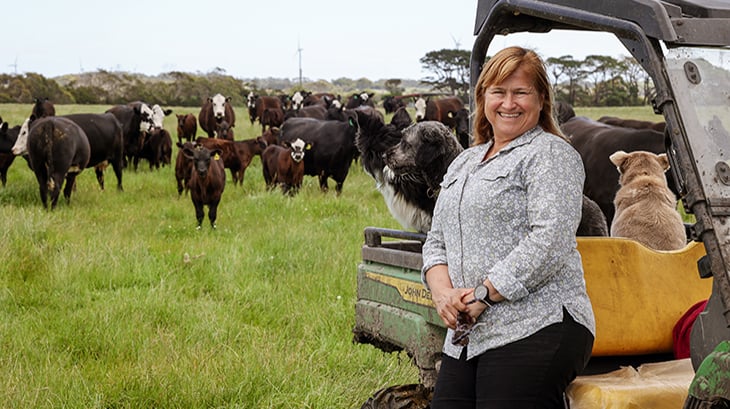Meet the SSG: Jenny O’Sullivan

SSG Member Jenny O’Sullivan.
We spoke with ABSF Sustainability Steering Group (SSG) member Jenny O’Sullivan, who runs a cattle and sheep farm in Victoria’s South Gippsland region.
How did you become involved in sustainability?
I have always loved agriculture and the environment so to be able to produce healthy nutritious food while improving the environment and creating livelihoods for our family and workers is very rewarding. The family farm is 644 hectares and about 15% is set aside for bush and infrastructure, including 83 hectares of remnant vegetation and shelter belts.
How has your experience in the grazing industries, plus professional training, positioned you to contribute to the ABSF and to the sustainability of the beef industry?
I studied agricultural science and love applying science to real life. We get to do that on the farm and in my other business “Linking Environment, Agriculture, and People”.
I enjoy being the Southern producers’ voice on the ABSF committee. We are looking at telling the story of beef production from all sectors and across Australia in our ABSF reports. My experience in facilitation and harnessing diverse views is also valuable in our consultation process. Also of value is my experience on farm striving to have a profitable red meat business whilst having a positive impact on the environment.
For us the important practices used when farming sustainably are:
- Good grazing management using rotational grazing
- Good water management to ensure livestock have clean water and our farming practices don’t have a negative impact on waterways running through our properties
- Sound soil management to build soil carbon and soil health with the use of soil tests to monitor changes over time
- Managing livestock to reduce emissions by using best practice and enabling carbon sequestration through trees and soils
- Monitoring our emissions profile
- Protecting, preserving and enhancing native biodiversity (fencing off bush)
- Creating shade and shelter for livestock (creating shelterbelts)
- Utilising a sound biosecurity plan together with an animal health and welfare plan
- Procedures for safe use of chemicals (weed control or animal health)
- Weed and pest procedures.
Why is sustainability so important to the Australian red meat sector?
Sustainable beef production means we look after the animals, the land, the people and our businesses. We want them all to thrive. If we don’t look after all of them, our businesses will eventually fail. Globally, consumers are becoming increasingly demanding to know the story behind their food. Luckily, we have a good story to tell.
The red meat industry has an enormous impact on regional Australia. The industry employs 191,700 people directly and has a turnover of $67.7 billion. This keeps Australians in jobs and feeds many people.
Also, the Australian red meat industry is committed to achieving carbon neutrality by 2030 (CN30) and we have reduced emissions by 64.1% since 2005. CN30 sends a clear message to global customers and consumers that the Australian red meat industry is serious about addressing greenhouse gas (GHG) emissions and is a global leader in progressing the sustainability of agricultural production.
We all need to play a part. The first step is understanding your emissions and level of sequestration and MLA has a number of programs available to help.
The Australian beef industry has shown that well-managed natural resources and livestock production are not mutually exclusive. In fact, healthy environments are intrinsically linked to the prosperity of agricultural businesses.
The Balance of Tree and Grass Cover which is monitoring what we do in Australia is unique in that it tracks net changes, considering both clearing and regrowth, enabling a more accurate capture of vegetation management. This is further supported by the latest data from the United Nations Food and Agriculture Organization, ranking Australia as Number Two for reforestation with an average net gain in forest area between 2010-2020 of 446,000 hectares per year. Also, native vegetation regrowth has seen the area of forest on Australian grazing properties increase from 12.94% in 2004 to 15.32% in 2020.
In addition, 7.6 million hectares of cattle-producing land – an area larger in size than Ireland – is set aside on Australian beef farms for conservation or protection purposes which is a significant commitment to enhancing biodiversity.
We are doing a good job, we need to keep doing it and need to tell our story.
More information
Contact:
Resources: